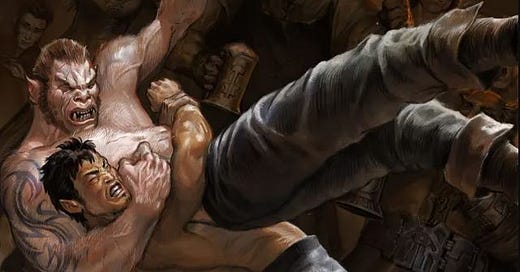As I’ve grown in my understanding of RPGs, I’ve come to believe that simplified mechanics only work at a macro level. The more intimate a situation, the more complex the mechanics need to be. This plays out most clearly in combat. As Matt Colville pointed out in one of his Baldur’s Gate 3 streams, D20 combat comes to us from Chainmail, which was written to facilitate large-scale battles. This system translates well to the skirmish-based combat that we see at parry scale, but it largely breaks down once you zoom in to man-to-man combat. Anyone who’s played games where dueling is a part of the fabric of the genre (i.e. Westerns, Samurai, etc) will tell you that 1-on-1 combat requires a satisfactory mechanic otherwise the whole game falls apart. If a Western game does not simulate gunfights properly, it’s basically worthless. What about unarmed combat though? A lot of games just treat unarmed combat as armed combat with no weapons. The result? Unarmed combat feels wrong. I discovered this firsthand last week when I tried to run a 1-on-1 session for one of my players in Castles & Crusades that was focused on pit fighting. C&C does not have a satisfactory system for unarmed combat. What game does though? Advanced Dungeons & Dragons 1st Edition.
As pointed out by my good friend Gelatinous Rube, AD&D’s Unarmed Combat Tables provide an interesting alternative to differentiate unarmed combat from armed. It’s percentile based rather than D20 plus modifier based and the results vary depending on what’s rolled. So instead of declaring that you’re going to put someone in a Sharpshooter, you would roll to grapple a prone opponent and a result of 21-40 would allow you to put an opponent in a limb lock like a Sharpshooter. The table says arm lock, but I imagine that Gygax would have made provision for the Sharpshooter if Bret Hart had been over in 1977 the way that was in the early 90’s. If these tables are so good though, why did they get deep-sixed by 2E?
The idea that specific mechanics are required to handle specific scenarios has become largely unfashionable. Why is that? Personally, I blame the story-focused gaming philosophies that could be found on places like The Forge. Without getting into the complexities of all of that (maybe I will in a different article), the prevailing attitude in gaming is that it’s more important to let people have moments like drop-kicking an Orc into the mouth of a Dragon than to make doing something like that achievable but difficult. Most games gladly advertise that you can drop kick an Orc into the mouth of a Dragon just by declaring what you want to do and then rolling a dice. It’s easy! Rules lite games just give you those moments for free, over and over again. There’s a problem though. Drop-kicking an Orc and slashing an orc with a longsword are exactly the same. It’s the same mechanic. Declare and then roll. By contrast, look at AD&D. To slash an Orc with a sword, you roll an attack, add your to-hit bonus, compare it to the Orc’s AC and then roll damage if you hit. To drop-kick an Orc, you roll percentile dice, tally up the modifiers and then check the table to see what happens and what kind of damage you can do.
The key difference here is that one system makes the process much simpler, but familiarity breeds contempt. You can drop kick to your heart’s content but after awhile it’s not going to feel as cool. By contrast, drop kicks are more involved in AD&D and the results are less consistent, but every great now and then you pull it off. It’s not something you can just do. It’s a process that could fail pretty easily, but when it works, it really works. It has a real impact to it. That’s what mechanics come down to at the end of the day. Can you successfully simulate the tension and impact of a fist fight? The more you strip away from the mechanics, the more anemic you make the action. This is one of the reasons why rules are so important to the game. The level of complexity has to match the scale at which you’re gaming. I think this is something that rules lite advocates miss more often than not. The complexity of certain rules is there for a reason and is necessary to keep the simulation afloat. Removing that complexity breaks the simulation and then the game is negatively affected.




